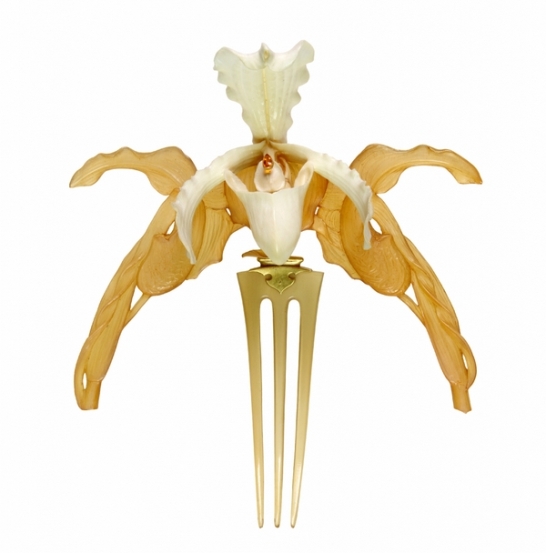There was sparkle, there was Markle and there was a beaming Harry. There were hats and horses and trumpets. Did you sit up late and drink champagne and munch on cucumber sandwiches and chocolate eclairs? I did some of that, even though I wasn’t at home but in a hotel room!
I’m sure you have your own opinion of the dress, the hair, the tiara, but I think we’ll probably all agree that Meghan’s veil was stupendous, all 5 metres of it!
Embed from Getty Images
Clare Waight Keller, artistic director at Givenchy and designer of Meghan Markle’s wedding dress, with a sample of the hand-embroidered lace that made up the veil.
According to a press release from Kensington Palace, Ms Markle expressed the wish of having all 53 countries of the Commonwealth with her on her journey through the ceremony with Ms Waight Keller designing a veil that represented the distinctive flora of each Commonwealth country united in one spectacular composition.
“Significant time was spent researching the flora of each Commonwealth country and much care was taken by Ms Waight Keller to ensure that every flower is unique.”
The veil was made from silk tulle with a trim of hand-embroidered flowers in silk threads and organza. Each flower was worked flat, in three dimensions with the embroiderers spending hundreds of hours meticulously sewing – and washing their hands every 30 minutes – to keep the tulle and threads pristine.
In addition to the flora of the Commonwealth, Ms Markle also selected two personal favourites:
Wintersweet (Chimonanthus praecox), which grows in the grounds of Kensington Palace in front of Nottingham Cottage (where she has been living with Prince Harry), and the California poppy (Eschscholzia californica), the state flower from Ms Markle’s place of birth.
Symmetrically placed at the very front of the veil, embroidered crops of wheat symbolised love and charity (and from what I understand are also a motif for fertility!).
New Zealand was represented by the kowhai flower with some others being: African violet (Saintpaulia) from Tanzania; Vanda Miss Joaquim orchid from Singapore; Victoria Regina water lily (Victoria amazonica) from Guyana; Cyclamen cyprium from Cyprus; teuila (Alpinia purpurata) from Samoa; Sepik blue orchid (Dendrobium lasianthera) from Papua New Guinea; bunchberry (Cornus canadensis) from Canada; thistle from Scotland; jasmine (Jasminum officinale) from Pakistan; and the spiral aloe (Aloe polyphylla) from Lesotho. Read the full list here.
Embed from Getty Images
The embroidery can be seen in this photo of the bride entering St George’s Chapel at Windsor Castle and, below, as she leaves.
Embed from Getty Images
Embed from Getty Images
Despite the extravagant use of flowers at the entry to St George’s Chapel, as can be seen above, the bride carried only a small posy bouquet.
Embed from Getty Images
The bridal bouquet carried by the Duchess of Sussex at her wedding was then laid on the Tomb of the Unknown Warrior in the west nave of Westminster Abbey in London.
The Palace press release notes that Prince Harry handpicked several flowers from the couple’s private garden at Kensington Palace to add to the bouquet designed by florist Philippa Craddock.
The spring blooms include forget-me-nots which were the favourite flower of Diana, Princess of Wales. The bouquet also including scented sweet peas, lily of the valley, astilbe, jasmine and astrantia, and sprigs of myrtle, all bound with a naturally dyed, raw silk ribbon.
The myrtle sprigs are from stems planted at Osborne House on the Isle of Wight, by Queen Victoria in 1845, and from a plant grown from the myrtle used in The Queen’s wedding bouquet of 1947.
The tradition of carrying myrtle begun after Queen Victoria was given a nosegay containing myrtle by Prince Albert’s grandmother during a visit to Gotha in Germany. In the same year, Queen Victoria and Prince Albert bought Osborne House as a family retreat, and a sprig from the posy was planted against the terrace walls, where it continues to thrive today.
The myrtle was first carried by Queen Victoria’s eldest daughter, Princess Victoria, when she married in 1858.




